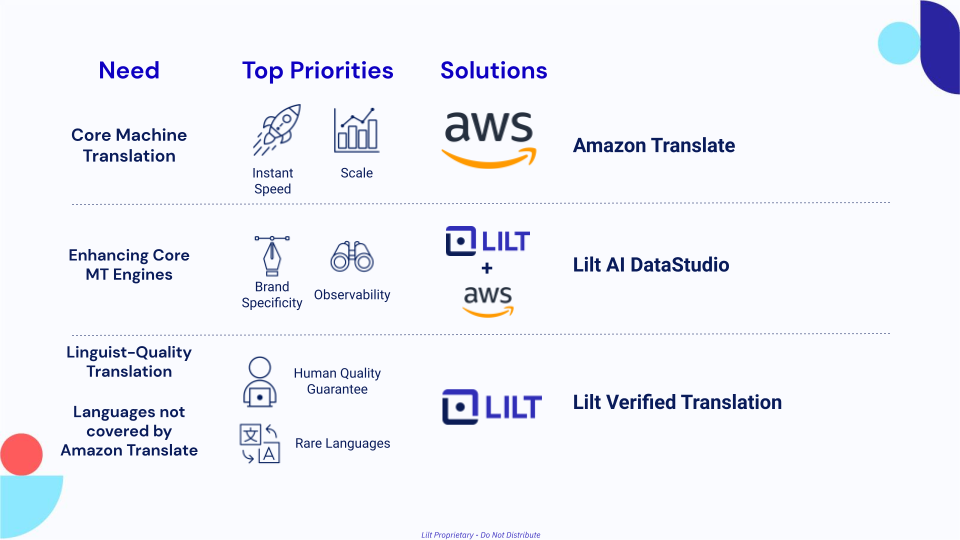Transforming Government Translation with AI: Webinar Recap

In today's increasingly interconnected world, language barriers can present serious challenges to public sector organizations. These organizations rely on effective communication to carry out their mission-critical tasks such as national security, public safety, healthcare, and education. To address these challenges, AI-driven language translation is now playing an essential role in transforming public sector workflows.
Recently, we held a webinar with the National Weather Service and UK Government to discuss how AI-driven language translation can improve communication in various domains. Key speakers included Jesse Rosenbaum, VP of National Security at Lilt, Sarah Sandberg, Senior Product Manager at Lilt, Monica Bozeman, Physical Scientist/Project Manager at the National Weather Service, and Evadne H. from the UK Law Enforcement Innovation.
Session 1
The Power of AI-enabled Translation: Boosting Efficiency, Speed, and Accuracy
 "We're experiencing that AI language translation is in the process of completely changing all these various aspects of our lives." - Jesse Rosenbaum, VP of National Security at Lilt
"We're experiencing that AI language translation is in the process of completely changing all these various aspects of our lives." - Jesse Rosenbaum, VP of National Security at Lilt
During the first session, Jesse Rosenbaum highlighted the importance of AI-driven language translation in the public sector, particularly with government organizations dealing with large volumes of complex content in multiple languages. By combining advanced AI technology with human expertise, government agencies can enhance their ability to communicate effectively and efficiently.
"Whether it's accuracy, security, if the language barrier just wasn't there and dissolved, what could you get done that you can't do today?" asked Rosenbaum. He emphasized the need for organizations to imagine the possibilities of using AI-driven translation technologies, such as Lilt's Contextual AI engine, to break down language barriers and improve mission outcomes.
Lilt's Contextual AI Engine is a key part of its language translation solution, enabling organizations to translate content quickly and accurately while adapting to the specific context of the text. During the webinar, Sarah Sandberg, a Senior Product Manager at Lilt, demonstrated how Lilt's Contextual AI Engine works through Adaptation, Prediction, and Comparison.
"With each confirmed translation segment, our memory training set increases and becomes more tailored to our voice and brand in real-time," explained Sandberg. This active reviewing and adaptation process is a core feature of Lilt's engine, allowing it to continuously learn and improve its translations based on expert Human Feedback.
Moreover, Lilt's instant translate feature allows users to quickly translate text or entire documents in a secure and efficient manner. Sandberg highlighted the importance of having a secure translation solution, noting that "Lilt Instant translate is also secure. We control the entire instance on-prem, meaning it's secure, it isn't being stored or sent to the cloud anywhere."
Session 2
Scaling AI Language Capabilities at Home: Civilian AI Translation Projects
 "Working in the Lilt interface, where [forecasters] had control over how the translation looked from the get-go and noticed that it would learn from them—that was a huge improvement." Monica Bozeman, Physical Scientist/Project Manager at the National Weather Service
"Working in the Lilt interface, where [forecasters] had control over how the translation looked from the get-go and noticed that it would learn from them—that was a huge improvement." Monica Bozeman, Physical Scientist/Project Manager at the National Weather Service
AI-driven translation can play a vital role in enhancing communication and collaboration in public sector missions, particularly in areas such as national security, public safety, healthcare, and education. Monica Bozeman, the Automated Language Translation Lead at the National Weather Service, shared her organization's experience in implementing Lilt's AI solution to improve their language translation capabilities.
She noted that AI-driven language translation can have a significant impact on public safety, as it can help dispatchers understand emergencies in different languages and improve response times.
"With San Juan, we actually had bilingual forecasters, which was a huge help," said Bozeman. "Using a translation tool such as Lilt helps you to translate everything without having to discern what to put forward first, helping you to then hone in on the relevant components of that translation."
Bozeman also emphasized the importance of having a secure and adaptable AI-driven translation solution, stating that "it's critical that security aspects of where and how we are able to securely access tooling such as Lilt or anything else, as well as how that those products manage and are trusted to manage the data which we are using."
Session 2
Ask the Security Experts: Enhancing National Security
The security and law enforcement community faces challenges in dealing with large amounts of data and different languages
In the final session, Evadne H. from the UK Law Enforcement Innovation discussed the growing challenge of dealing with massive amounts of data and multiple languages in law enforcement and security work. The issue is not just about language translation, but also about data formatting and being able to quickly access and analyze information.
Evadne explained that with the increasing usage of the internet and encrypted communications, the sheer scale of information that needs to be processed presents a real challenge for law enforcement agencies. "Data is a challenge which we are never going to get away from. It's going to continually grow," she said.
To address this issue, Evadne highlighted the potential of AI and machine translation tools, such as Lilt, to help process large volumes of data and language sets more efficiently. She shared powerful user stories that demonstrate the impact of AI technology in speeding up translation and analysis processes, as well as the potential for increased collaboration and sharing of information between agencies and partners.
 "The ability to share AI models across organizations and even between different partners can help improve translation capabilities and address challenges related to data management and language translation." - Evadne H. from the UK Law Enforcement Innovation.
"The ability to share AI models across organizations and even between different partners can help improve translation capabilities and address challenges related to data management and language translation." - Evadne H. from the UK Law Enforcement Innovation.
She also emphasized the need for human review to ensure the accuracy and integrity of translation outputs—especially in high-stakes situations—and the potential for AI technology to be integrated into other aspects of law enforcement work, such as speech-to-text applications and real-time translation for communication with the public.
Conclusion
Overall, this webinar provided valuable insights on how AI-driven language translation can help public sector organizations to overcome language barriers, improve communication, and enhance collaboration. As AI technologies continue to advance, it is crucial for government organizations to develop a clear and actionable AI strategy to stay ahead of the curve.
.jpg?width=1356&height=207&name=Lilt-Blog%20CTA%20(4).jpg)


